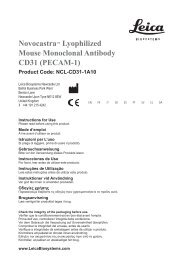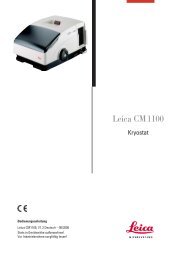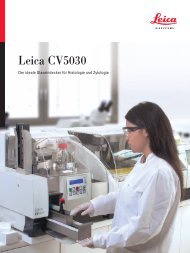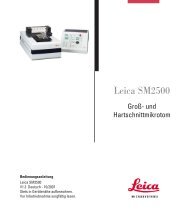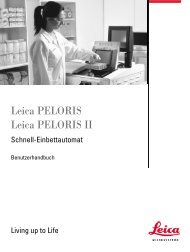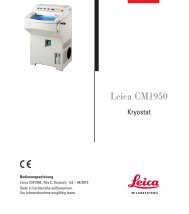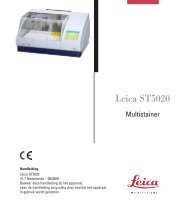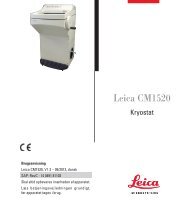Info - Leica Biosystems
Info - Leica Biosystems
Info - Leica Biosystems
You also want an ePaper? Increase the reach of your titles
YUMPU automatically turns print PDFs into web optimized ePapers that Google loves.
Positive Tissue Control<br />
Used to indicate correctly prepared tissues and proper staining techniques.<br />
One positive tissue control should be included for each set of test conditions in each staining run.<br />
A tissue with weak positive staining is more suitable than a tissue with strong positive staining for optimal quality control and to detect<br />
minor levels of reagent degradation. 2<br />
Recommended positive control tissue is tonsil.<br />
If the positive tissue control fails to demonstrate positive staining, results with the test specimens should be considered invalid.<br />
Negative Tissue Control<br />
Should be examined after the positive tissue control to verify the specificity of the labeling of the target antigen by the primary antibody.<br />
Recommended negative control tissue is skeletal muscle.<br />
Alternatively, the variety of different cell types present in most tissue sections frequently offers negative control sites, but this should be<br />
verified by the user.<br />
Non-specific staining, if present, usually has a diffuse appearance. Sporadic staining of connective tissue may also be observed in<br />
sections from excessively formalin-fixed tissues. Use intact cells for interpretation of staining results. Necrotic or degenerated cells often<br />
stain non-specifically. 3 False-positive results may be seen due to non-immunological binding of proteins or substrate reaction products.<br />
They may also be caused by endogenous enzymes such as pseudoperoxidase (erythrocytes), endogenous peroxidase<br />
(cytochrome C), or endogenous biotin (eg. liver, breast, brain, kidney) depending on the type of immunostain used. To differentiate<br />
endogenous enzyme activity or non-specific binding of enzymes from specific immunoreactivity, additional patient tissues may be stained<br />
exclusively with substrate chromogen or enzyme complexes (avidin-biotin, streptavidin, labeled polymer) and substrate-chromogen,<br />
respectively. If specific staining occurs in the negative tissue control, results with the patient specimens should be considered invalid.<br />
Negative Reagent Control<br />
Use a non-specific negative reagent control in place of the primary antibody with a section of each patient specimen to evaluate<br />
non-specific staining and allow better interpretation of specific staining at the antigen site.<br />
Patient Tissue<br />
Examine patient specimens stained with NCL-L-IgM last. Positive staining intensity should be assessed within the context of any<br />
non-specific background staining of the negative reagent control. As with any immunohistochemical test, a negative result means that<br />
the antigen was not detected, not that the antigen was absent in the cells/tissue assayed. If necessary, use a panel of antibodies to<br />
identify false-negative reactions.<br />
Results Expected<br />
Normal Tissues<br />
Clone 8H6 detected the IgM protein, in the cytoplasm and on the membrane of cells of B cell lineage. In addition to infiltrating B<br />
lymphocytes, the IgM protein was detected in a variety of tissues including adrenal gland, small bowel mucosa, colon mucosa, stomach<br />
mucosa, liver, heart, pancreas, salivary gland, nerve elements in the white matter of the cerebellum, pituitary gland, lung, ovary, prostate,<br />
thymus and Leydig cells of the testis. (n=142).<br />
Abnormal Tissues<br />
Clone 8H6 detected the IgM protein in 18/46 hematological malignancies evaluated, including 7/10 diffuse large B cell lymphomas, 3/7<br />
follicular lymphomas, 5/7 mantle cell lymphomas 2/3 anaplastic large cell lymphomas, 1/3 MALTomas, 0/6 peripheral T cell lymphomas,<br />
0/5 Hodgkin’s lymphomas , 0/1 malignant lymphoma, 0/1 T cell rich B-cell lymphoma, 0/1 NK/T cell lymphoma, 0/1 Burkitt’s lymphoma,<br />
and 0/1 B cell tumor of the gut. Except for infiltrating lymphocytes, IgM was also detected in 11/69 non-lymphoid tumors including 1/7<br />
sarcomas, 1/5 breast tumors, 4/4 kidney tumors, 1/4 neuroendocrine tumors, 1/3 germ cell tumors, 1/3 endometrial tumors, 1/2 stomach<br />
tumors and 1/2 pancreatic tumors.<br />
NCL-L-IgM is recommended for use as part of an antibody panel for the classification of tumors of B cell origin.<br />
General Limitations<br />
Immunohistochemistry is a multistep diagnostic process that consists of specialized training in the selection of the appropriate reagents;<br />
tissue selection, fixation, and processing; preparation of the IHC slide; and interpretation of the staining results.<br />
Tissue staining is dependent on the handling and processing of the tissue prior to staining. Improper fixation, freezing, thawing, washing,<br />
drying, heating, sectioning or contamination with other tissues or fluids may produce artifacts, antibody trapping, or false negative<br />
results. Inconsistent results may be due to variations in fixation and embedding methods, or to inherent irregularities within the tissue. 4<br />
Excessive or incomplete counterstaining may compromise proper interpretation of results.<br />
The clinical interpretation of any staining or its absence should be complemented by morphological studies using proper controls and<br />
should be evaluated within the context of the patient’s clinical history and other diagnostic tests by a qualified pathologist.<br />
Antibodies from <strong>Leica</strong> <strong>Biosystems</strong> Newcastle Ltd are for use, as indicated, on either frozen or paraffin-embedded sections with specific<br />
fixation requirements. Unexpected antigen expression may occur, especially in neoplasms. The clinical interpretation of any stained<br />
tissue section must include morphological analysis and the evaluation of appropriate controls.<br />
Bibliography - General<br />
1. National Committee for Clinical Laboratory Standards (NCCLS). Protection of laboratory workers from infectious diseases transmitted<br />
by blood and tissue; proposed guideline. Villanova, P.A. 1991; 7(9). Order code M29-P.<br />
2. Battifora H. Diagnostic uses of antibodies to keratins: a review and immunohistochemical comparison of seven monoclonal and<br />
three polyclonal antibodies. Progress in Surgical Pathology. 6:1–15. eds. Fenoglio-Preiser C, Wolff CM, Rilke F. Field & Wood, Inc.,<br />
Philadelphia.<br />
3. Nadji M, Morales AR. Immunoperoxidase, part I: the techniques and pitfalls. Laboratory Medicine. 1983; 14:767.<br />
4. Omata M, Liew CT, Ashcavai M, Peters RL. Nonimmunologic binding of horseradish peroxidase to hepatitis B surface antigen: a<br />
possible source of error in immunohistochemistry. American Journal of Clinical Pathology. 1980; 73:626.<br />
5. Geisberger R, Lamers M and Achatz G. The riddle of the dual expression of IgM and IgD. Immunology 2006; 118: 429-437.<br />
NCL-L-IgM<br />
Page 3



